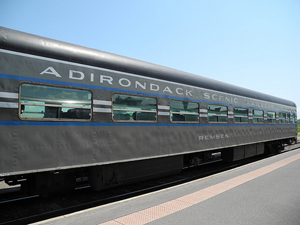Happening Now
Hopping the Local: Eyes on the Track Ahead (Part 2)
August 14, 2012
Written By Malcolm Kenton
Part 2 of our 3-part series of dispatches from track level across the country:

A small group of residents of New York State's Adirondack region areorganizing an online petition drive to prevent the middle section of what is now the Adirondack Scenic Railroad (ASRR) from being converted into a bicycle trail. This former branch of the New York Central Railroad once took passengers all the way to Lake Placid from off the main line in Utica. Now, the ASRR operates trains in 2 sections: Utica to Thendara and Saranac Lake to Lake Placid. The volunteer-run railroad has been working to raise funds to restore service over the entire line, which would reconnect a remote region with few travel options other than driving to the national passenger train network (ASRR and Amtrak share Utica Union Station), and there's no reason a bike trail can't parallel the rail line. If you support this cause, you are welcome to sign the petition.
All Aboard Washington Executive Director Lloyd Flem says we all need to be better ambassadors for the train service we already have. Even in the Pacific Northwest, one of the regions that is fairly well served by passenger trains, there are some in Seattle and Olympia who don’t like having to drive to Portland and are, incredibly, completely unaware that there is frequent parallel train service.
The Delaware Valley Rail Passenger (May 2012), monthly publication of the Philadelphia-area Delaware Valley Association of Rail Passengers, weighs the question of whether or not to support the Delaware Valley Regional Planning Commission’s three planned Bus Rapid Transit (BRT) routes between Camden and points south and east—which many fear would come to be seen as a replacement for a Camden-Glassboro rail transit corridor, which has long been a DVARP priority. The $46 million BRT project got a $2.6 million federal New Starts grant in July. Rail transit, using an existing Conrail freight right-of-way, would serve walkable residential areas and would enable less car-dependent lifestyles for more residents, DVARP argues. BRT, on the other hand, would use highways, requiring most riders to drive to its stations. DVARP has raised other questions about how the BRT lines are being designed. Either BRT or rail would connect at Camden with PATCO heavy rail into Philadelphia and the River LINE light rail to Trenton.
The July-August Rail Passenger congratulates the Southeast Pennsylvania Transportation Authority (SEPTA) on winning the American Public Transportation Association’s Outstanding Public Transportation System Achievement Award for “ridership growth, new, customer service initiatives, energy conservation projects, improved relations with riders and local government, and very well-managed finances.” It also notes that the last of the Silverliner II and III cars, long the workhorses of SEPTA’s Regional Rail service, were retired June 29. Now, virtually all Regional Rail trains consist of new Silverliner V cars, featuring more comfortable seats, better accessibility for special-needs passengers, bigger windows and electronic next station displays.
From All Aboard: Rhode Island, the newsletter of the Rhode Island Association of Railroad Passengers (Summer 2012): A study is underway to determine what major improvements need to be made to Providence’s downtown Amtrak and MBTA commuter rail station, Rhode Island DOT consultant Stephen Derdiarian told RIARP members at a joint RIARP/Coalition for Transportation Choices meeting on June 4. The study’s recommended alternative is the most expensive one, but also the one that saves the most money in the long run. It would involve replacing the deck over the station’s underground parking garage, completely redesigning the park between Park Row and the station, and replacing the station’s existing limestone façade (facing the State Capitol) with more durable granite.
"The National Association of Railroad Passengers has done yeoman work over the years and in fact if it weren’t for NARP, I'd be surprised if Amtrak were still in possession of as a large a network as they have. So they've done good work, they're very good on the factual case."
Robert Gallamore, Director of Transportation Center at Northwestern University and former Federal Railroad Administration official, Director of Transportation Center at Northwestern University
November 17, 2005, on The Leonard Lopate Show (with guest host Chris Bannon), WNYC New York.
Comments